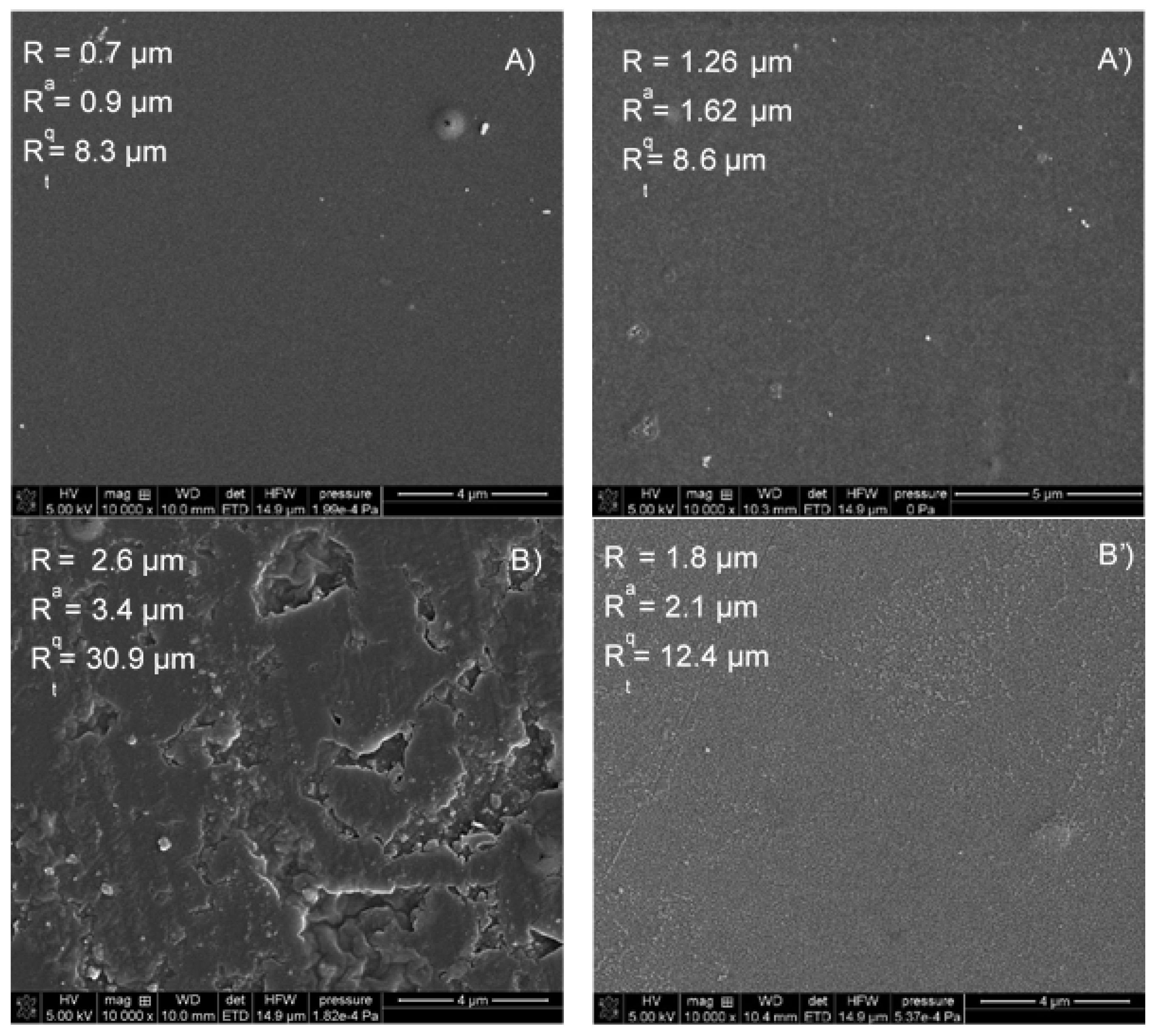Surface Properties of Plasma-Activated Chitosan Foils
Abstract
:1. Introduction
2. Materials and Methods
Method of Chitosan Preparation
3. Results
4. Conclusions
Supplementary Materials
Author Contributions
Funding
Institutional Review Board Statement
Informed Consent Statement
Data Availability Statement
Conflicts of Interest
References
- Terpiłowski, K.; Wiącek, A.E.; Jurak, M. Influence of nitrogen plasma treatment on the wettability of polyetheretherketone and deposited chitosan layers. Adv. Polym. Technol. 2018, 37, 2166–2174. [Google Scholar] [CrossRef] [Green Version]
- Molina, R.; Jovanic, P.; Vilchez, S.; Tzanov, T.; Solans, C. In situ chitosan gelation initiated by atmospheric plasma treatment. Carbohydr. Polym. 2012, 4, 2745–2749. [Google Scholar] [CrossRef] [PubMed]
- Tkvac, T.; Petrinič, I.; Luxbacher, T.; Vesel, A.; Ristič, T.; Zemlič, L.F. Influence of O2 and CO2 plasma treatment on the depositionof chitosan onto polyethylene terephthalate (PET) surfaces. Int. J. Adhes. Adhes. 2014, 48, 168–176. [Google Scholar] [CrossRef]
- Ozbay, S.; Erdogan, N.; Erden, F.; Ekmekcioglu, M.; Ozdemir, M.; Aygun, G.; Ozyuzer, L. Surface free energy analysis of ITO/Au/ITO multilayer thinfilms onpolycarbonate substrate by apparent contact angle measurements. Appl. Surf. Sci. 2020, 529, 147111. [Google Scholar] [CrossRef]
- Liu, Y.; Wu, C.; Bai, Y.; Shuyu, L.; Yuan, C.; Ding, T.; Hu, Y. Effect of glow discharge plasma on surface modification of chitosan film. Int. J. Biol. Macromol. 2019, 138, 340–348. [Google Scholar] [CrossRef] [PubMed]
- Chang, S.H.; Chian, C.H. Plasma surface modification effects on biodegradability and protein adsorption properties of chitosan films. Appl. Surf. Sci. 2013, 282, 735–740. [Google Scholar] [CrossRef]
- Silva, S.S.; Luna, S.M.; Gomes, M.E.; Benesch, J.; Pashkuleva, I.; Mano, J.F.; Reis, R.L. Plasma Surface Modification of Chitosan Membranes: Characterisation and Preliminary Cell Response Studies. Macromol. Biosci. 2008, 8, 568–576. [Google Scholar] [CrossRef] [PubMed] [Green Version]
- Chibowski, E. Contact angle hysteresis due to a film present behind the drop. In Contact Angle, Wettability and Adhesion, 2nd ed.; Mittal, K.L., Ed.; VSP: Utrecht, The Netherlands, 2002; Volume 2, pp. 265–288. [Google Scholar]
- Van Oss, C.J.; Good, R.J.; Chaudhury, M.K. The role of van der Waals forces and hydrogen bonds in “hydrophobic interactions” between biopolymers and low energy surfaces. J. Colloid Interface Sci. 1986, 111, 378–390. [Google Scholar] [CrossRef]
- Tadmor, R. Line energy and the relation between advancing, receding, and young contact angles. Langmuir 2004, 20, 7659–7664. [Google Scholar] [CrossRef] [PubMed]
- Fernandes Queiroz, M.; Teodosio Melo, K.R.; Araujo Sabry, D.; Lanzi Sassaki, G.; Oliveira Rocha, H.A. Does the Use of Chitosan Contribute to Oxalate Kidney Stone Formation? Mar. Drugs 2015, 13, 141–158. [Google Scholar] [CrossRef] [PubMed]


Publisher’s Note: MDPI stays neutral with regard to jurisdictional claims in published maps and institutional affiliations. |
© 2022 by the authors. Licensee MDPI, Basel, Switzerland. This article is an open access article distributed under the terms and conditions of the Creative Commons Attribution (CC BY) license (https://creativecommons.org/licenses/by/4.0/).
Share and Cite
Terpiłowski, K.; Chibowski, E. Surface Properties of Plasma-Activated Chitosan Foils. Colloids Interfaces 2022, 6, 6. https://doi.org/10.3390/colloids6010006
Terpiłowski K, Chibowski E. Surface Properties of Plasma-Activated Chitosan Foils. Colloids and Interfaces. 2022; 6(1):6. https://doi.org/10.3390/colloids6010006
Chicago/Turabian StyleTerpiłowski, Konrad, and Emil Chibowski. 2022. "Surface Properties of Plasma-Activated Chitosan Foils" Colloids and Interfaces 6, no. 1: 6. https://doi.org/10.3390/colloids6010006





